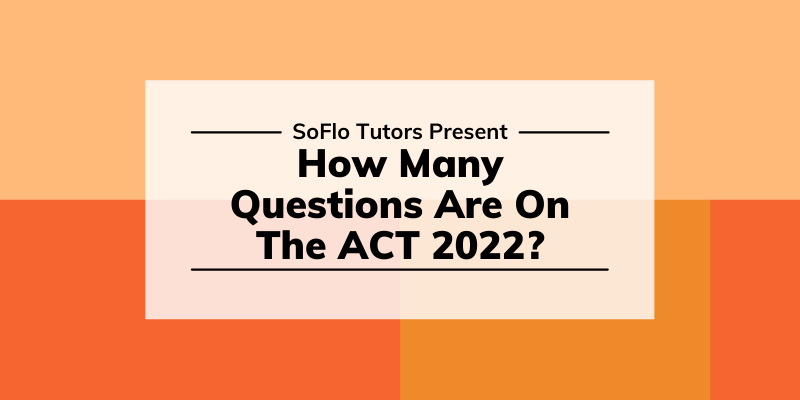
How Many Questions Is The ACT Test?
When taking the ACT, it’s important to know how many questions are on each section. Knowing how much time you have per question is important for preparing, especially if you want to practice your time management skills. Here’s some information on how many questions are on the ACT, and tips and tricks crucial for acing the test.
How Long Does the ACT Take And How Many Questions Are On The Test?
In total, there are 215 questions on the ACT, with an optional essay.
You will have 2 hours and 55 minutes to finish the test (3 hours and 35 minutes if you choose to do the essay) but be aware that you do not have an equal amount of time per section.
Here’s a handy breakdown of how much time you have per each section of the test:
| Section time | Number of questions | Time per question | |
| English | 45 minutes | 75 questions | 36 seconds |
| Math | 60 minutes | 60 questions | 1 minute |
| Reading | 35 minutes | 40 questions | 53 seconds |
| Science | 35 minutes | 40 questions | 53 seconds |
| Optional Essay | 40 minutes | 1 prompt | 40 minutes |
| Total | 2 hours and 55 minutes (3:35 with the essay) | 215 questions, 1 optional essay | Varies |
Students will get one ten-minute break after the Math portion of the ACT, and if they’re choosing to do the optional essay, another five-minute break after the Science section.
How Many Questions are on the ACT English?
There are 75 questions on the English section of the ACT, and students have 45 minutes to complete the section.
The English section tests grammar, word usage, punctuation, proper sentence structure, organization, and general style by asking students to edit short passages.
Each question is multiple choice, with four answer choices per question. Here’s a little snippet from a real test showing you the types of questions on the English section:
Most of the questions will take the format of question 3, and ask students to revise (or leave alone!) an underlined portion of the presented passage. Others, like question 4, will ask students to consider adding or removing a sentence from the passage, and to explain their choice. A third type of question will ask students to evaluate the purpose of a portion of the text, or ask if a proposed edit fulfills a certain purpose.
This is the section with the most number of questions and the least amount of time per question. Don’t be afraid, though – the test is designed to be completed in the given amount of time!
In this section, each question is made to be answered with a quick mental reference to grammar rules and your judgement. If you find yourself thinking about a question for too long, leave it for the end.
How Many Questions are on the ACT Math?
There are 60 questions on the Math section of the ACT, and students have 60 minutes to complete the section. The Math section tests skills that students have learned in their math classes up to grade 12 of a normal high school curriculum, including pre-algebra, algebra, geometry, and trigonometry.
Each question is multiple-choice, with five answer choices per question. While most questions are standalone, some sets of questions will ask you to refer to a table or a diagram to answer more than one question – don’t be caught off guard by these!
Unlike the English section, the Math section gets progressively harder. This means that as you continue in the section, the problems will get harder and harder towards the end.
Pro tip: while you have one minute per question on the Math section, there is no need to limit yourself to one minute per question, especially with the more difficult questions at the end. Plan on spending less time per question towards the beginning, and use that saved time to your advantage when solving harder problems.
How Many Questions are on the ACT Reading?
There are 40 questions on the Reading section of the ACT, and students have 35 minutes to complete the section.
The Reading section tests students’ reading comprehension skills, including their ability to read closely, reason about passages using direct evidence, and use information from two passages to answer questions.
Each question is multiple-choice, with four choices per question. Unlike the English or Math sections, the Reading section is split into four passages of about 800 to 1000 words per passage, and each passage will be tested with ten questions each.
Similar to the Math section, the questions towards the end get harder, which means that the last two passages will usually be harder than the first two.
The Reading section is unique in that questions are broken up between four length passages. Students are often intimidated by how long the passages can be, but there’s no need to be! You should remember that the purpose of the section is about using evidence from the text to answer the given questions.
There are four types of subjects that the passages can cover:
- Literature
- Humanities
- Social Sciences
- Natural Sciences
Remember, you don’t need to know background information about the topics to answer the questions!
Often, questions will look like this and ask students to refer to a portion of the passage:
The key to solving questions like these is to read the referenced lines before reading the given answers. Often, incorrect answer choices will try to trick you into choosing them, so always refer back to the text for information.
Remember, every question can be answered by direct evidence from the text!
How Many Questions are on the ACT Science?
There are 40 questions on the Science section of the ACT, and students have 35 minutes to complete the section. The Science section tests interpretation, analysis, reasoning, and problem-solving skills necessary in the natural sciences.
Each question is multiple-choice, with four choices per question. Similar to the Reading section, the Science section is broken up into multiple scientific scenarios on which students will need to answer questions.
There are three ways that the scientific information can be presented:
- Data Representation. This includes charts, tables, and graphs similar to ones that might be found in a scientific article. Questions will test students on interpreting the data from these diagrams.
- Research Summaries. This format will describe one or more experiments and ask students about the design and interpretation of these experiments.
- Conflicting Viewpoints. In these, students will be asked to look at alternate explanations for a scientific phenomenon and analyze the differences between competing hypotheses.
Some background knowledge in natural sciences like biology, chemistry, and physics is necessary, but remember, most of this section is designed around using logic and reasoning to interpret given information.
Don’t worry if you’re not an expert in science – most of the information you need to answer the questions is already given to you.
How is the Overall Score Calculated?
Raw Score vs Scale Score
For each section, you are given one point for every question that you get correct, and zero points for every question that you miss or get wrong.
Note that there is no guessing penalty! You should always try to answer every question, even if you have to guess. This calculates your raw score.
This raw score is then turned into a scale score for each section. While the score chart for every test can be different, here’s an example from a practice test that will show you approximately how the scale score is calculated:
Composite Score
The composite score is just the average of the scale scores from each section. To calculate it, just add together each section’s scale score and divide by four, rounding to the nearest whole number if you need to.
How Many Questions Can You Miss on the ACT and Still Get a Good Result?
This is a common question that we get at SoFlo tutors, and the answer is that it depends.
First, you should think about what would be a good composite score for you. If you really wanted to shoot for a 31, for example, you could miss 10 questions from English, 10 questions from Math, 7 questions from Reading, and 6 questions from Science to get a 31 scale score in each section, using the example chart above.
However, if you’re weaker in one section compared to another, don’t fret! The ACT test is about knowing what your strengths and weaknesses are. If you’re a math whiz but struggle with English, you can still get your desired score if you get a sufficiently high score on Math and don’t miss too many on English.
Start Preparing for the ACT with Soflo
Just knowing about how many questions are on the ACT isn’t enough, though – real practice with a skilled tutor is the best way to improve! ACT tutors at SoFlo are experts on every aspect of the test, achieved high scores on the ACT and SAT, and attend elite universities.
If you want to improve on the ACT or the SAT, contact us here for a free consultation to match with a tutor that will work for you.
About the Author Section
Sukwon Jeong is from Charlotte, North Carolina, and is currently a student at Vanderbilt University double majoring in Economics and History. When not being an incredible tutor for SoFlo, he can be found reading twentieth century Japanese literature, obsessing over brewing the perfect cup of coffee, and terribly playing the piano.
Sources
- https://www.act.org/content/act/en/products-and-services/the-act.html
- https://www.act.org/content/act/en/products-and-services/the-act/test-preparation/description-of-science-test.html
- https://www.act.org/content/act/en/products-and-services/the-act/test-preparation/description-of-english-test.html
- https://www.act.org/content/act/en/products-and-services/the-act/test-preparation/description-of-math-test.html
- https://www.act.org/content/act/en/products-and-services/the-act/test-preparation/description-of-reading-test.html
- https://soflotutors.com/blog/how-to-prepare-for-the-act-test-2022/










